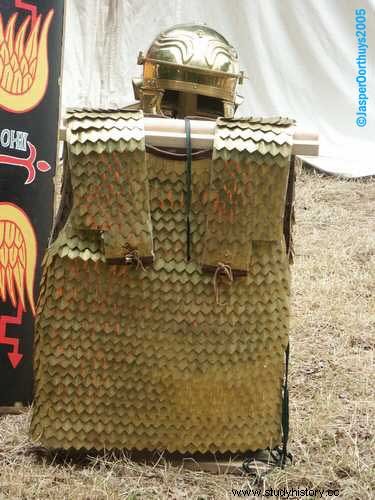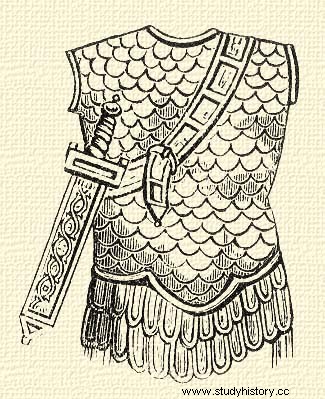Lorica:name of body defenses (often called armor) in ancient Rome.
Squamata:Having the appearance of scaly skin, covered with “scales”.
The lorica squamata are therefore broignes or corselets of scales whose appearance is reminiscent of scaly skin.

After the disaster of the capture of Rome (about -350) the troops of the Latin league were reformed. The bronze cuirasses were abandoned in favor of the defense of the Celtic adversary, that is to say the annular chain mail (Lorica Hamata). Following the Roman conquests in Greece, the Roman legionnaires discovered, and for some adopted, the Linothorax in its version entirely covered with scales.
The representations generally show shapes close to the "standard" shape of Lorica Hamata or kinds of sleeveless vests.

Inspired by the linothoraxes and the cataphracts, the lorica squamata therefore take up the principle of a garment on which twins are fixed (or stitches, the terms are anachronistic). All of these reinforcement pieces give an impression of scales which gave its name to this defense. Iron/steel seems to have been used almost exclusively by the Roman legions. The legionnaires seem to have retained a series of models where the "scales" were fixed by their tops and where the lower parts remained free.
The scales were arranged in horizontal rows. Each row being offset from the next, the arrangement of the whole is reminiscent of the arrangement of tiles on a roof. Fastening was provided by pairs of holes at the top of the scale. The scales were often domed or ribbed. (increased resistance) Most of the twins found approach a module 10 to 20 mm wide by 20 to 30 mm high with the edge left free rounded. However the Roman army never used regulatory uniforms in the sense we understand it. In fact, among the dozens of types of scales found, some are very different. It is not even excluded that some legionnaires did not replace this broigne by models from the Middle East or even by a "shell breastplate" (see the cataphracts).
Except for the "exotic" models directly inspired by the models of the Middle East, the lorica hamata protected many blows from top to bottom and transverse blows. Bottom-up hits were a problem, as they could displace the "scales" and cut their way into the flesh. Spikes were the most dangerous for someone protected by such a system.
